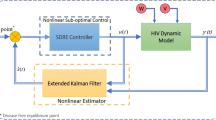Abstract
In this paper, a robust adaptive controller subject to decoupled sliding mode controller as a supervisory controller has been implemented on the HIV infection dynamic model. A five-state dynamic model of HIV is utilized which the measurement of the CD4+T cells and the viral load counts are necessary to estimate all its parameters. Decoupled sliding mode control is a variable structure controller having significant and appropriate features, such as best tracking and regulation performance and robustness and elevate the performance of the controller. Generally, due to the importance of applied treatment strategy to mitigate viral escape, sliding mode control is utilized in accordance with PI control to deliver necessary control inputs. To achieve the least possible chattering, effectual methods such as the transfer function is used. To update the gains of PI control, an adaptation law is then employed. The results demonstrate the suitable performance of the controller via providing proper tracking performance, and also, elimination of the chattering problem and decrease the time of treatment. The number of infected CD4+ T-cells and the number of free virus particles can be controlled in less than five days. The proposed controller is capable of controlling the dynamic behavior of the virus concentration for different patients with the same control scheme.
Similar content being viewed by others
References
R. Quax, D.A.M.C. van de Vijver, D. Frentz, P.M.A. Sloot, Eur. Phys. J. Special Topics 222, 1347 (2013)
H. Chang, A. Astolfi, IEEE Control Syst. 28, 28 (2008)
D.A.M.C. van de Vijver, M.C.F. Prosperi, J.J. Ramasco, Eur. Phys. J. Special Topics 222, 1403 (2013)
P.K. Roy, Mathematical models for therapeutic approaches to control HIV disease transmission (Springer, Singapore, 2015)
M. Joly, J.M. Pinto, AIChE J. 52, 856 (2006)
K.O. Okosun, M.A. Khan, E. Bonyah, S.T. Ogunlade, Eur. Phys. J. Plus. 132, 363 (2017)
S.M.K. Heris, H. Khaloozadeh, IEEE Trans. Biomed. Eng. 58, 1678 (2011)
M.E. Brandt, G. Chen, IEEE Trans. Biomed. Eng. 48, 754 (2001)
S.S. Ge, Z. Tian, T.H. Lee, IEEE Trans. Biomed. Eng. 52, 353 (2005)
Y. Liu, Feedback linearization and optimal design for the control of an HIV pathogenesis model, in Control and Decision Conference (CCDC), 2015 27th Chinese (IEEE, 2015), pp. 1482–1486
F.L. Biafore, C.E. D’Attellis, Exact Linearisation and Control of a HIV-1 Predator-Prey Model, in Engineering in Medicine and Biology Society, 2005. IEEE-EMBS 2005. 27th Annual International Conference (IEEE, 2006), pp. 2367–2370
H. Chang, A. Astolfi, IEEE Trans. Autom. Sci. Eng. 6, 248 (2009)
B.M. Adams, H.T. Banks, M. Davidian, H.-D. Kwon, H.T. Tran, S.N. Wynne, E.S. Rosenberg, J. Comput. Appl. Math. 184, 10 (2005)
H. Shim, S.-J. Han, C.C. Chung, S.W. Nam, J.H. Seo, Int. J. Control Autom. Syst. 1, 282 (2003)
G. Pannocchia, M. Laurino, A. Landi, IEEE Trans. Biomed. Eng. 57, 1040 (2010)
M.R. Zarrabi, M.H. Farahi, S. Effati, A.J. Koshkouei, Adv. Model. Optim. 14 (2012)
N.H. Jo, Y. Roh, Biomed. Signal Process. Control. 18, 245 (2015)
J.M. Lemos, M.S. Barão, Arch. Control Sci. 22, 273 (2012)
W. Assawinchaichote, Biomed. Mater. Eng. 26, S1945 (2015)
A. Kosari, H. Jahanshahi, A. Razavi, J. Aerosp. Eng. 30, 4017011 (2017)
A.I. Dounis, P. Kofinas, C. Alafodimos, D. Tseles, Renew. Energy. 60, 202 (2013)
M.A. Khanesar, O. Kaynak, S. Yin, H. Gao, IEEE Trans. Fuzzy Syst. 23, 205 (2015)
A. Saghafinia, H.W. Ping, M.N. Uddin, K.S. Gaeid, IEEE Trans. Ind. Appl. 51, 692 (2015)
W.M. Bessa, A.S. De Paula, M.A. Savi, Eur. Phys. J. Special Topics 222, 1541 (2013)
W.-S. Yu, C.-C. Weng, Fuzzy Sets Syst. 248, 1 (2014)
B. Niu, J. Zhu, Y. Su, H. Li, L. Li, Nonlinear Dyn. 73, 1803 (2013)
Y. Li, Q. Xu, IEEE Trans. Control Syst. Technol. 18, 798 (2010)
J.Y. Peng, X.B. Chen, IEEE/ASME Trans. Mechatronics. 19, 88 (2014)
D. Wodarz, M.A. Nowak, Proc. Natl. Acad. Sci. 96, 14464 (1999)
D. Wodarz, M.A. Nowak, BioEssays. 24, 1178 (2002)
J.H. Ko, W.H. Kim, C.C. Chung, IEEE Trans. Biomed. Eng. 53, 380 (2006)
L.-C. Hung, H.-Y. Chung, Int. J. Approx. Reason. 46, 74 (2007)
Author information
Authors and Affiliations
Corresponding author
Rights and permissions
About this article
Cite this article
Jahanshahi, H. Smooth control of HIV/AIDS infection using a robust adaptive scheme with decoupled sliding mode supervision. Eur. Phys. J. Spec. Top. 227, 707–718 (2018). https://doi.org/10.1140/epjst/e2018-800016-7
Received:
Published:
Issue Date:
DOI: https://doi.org/10.1140/epjst/e2018-800016-7




